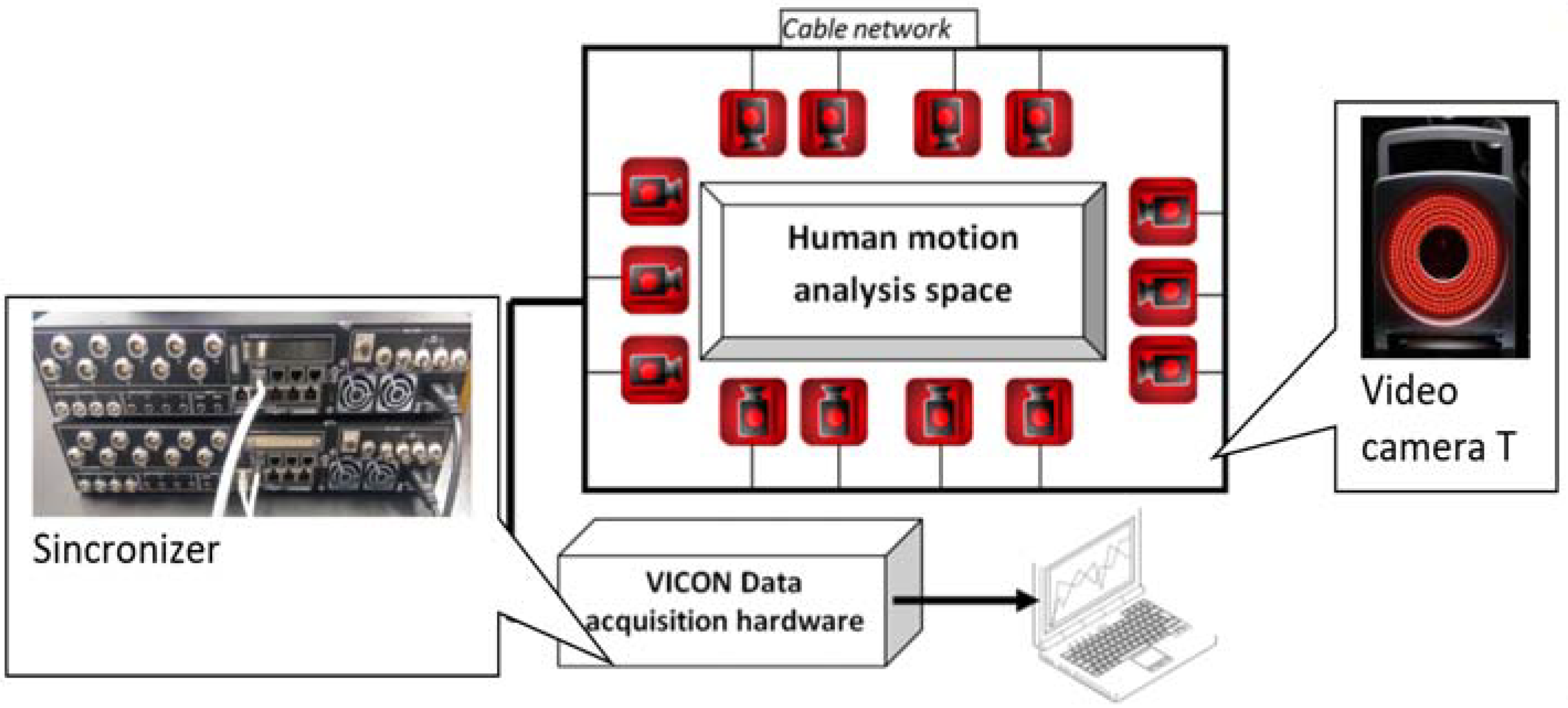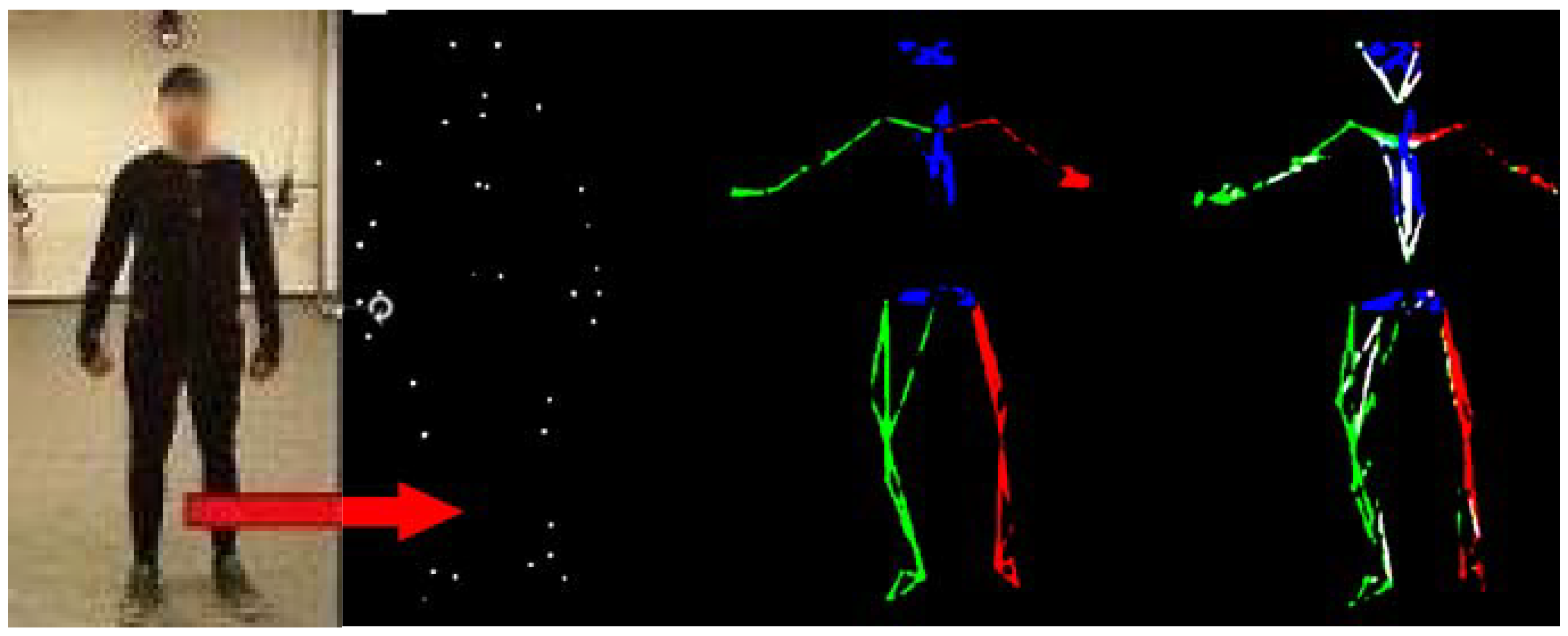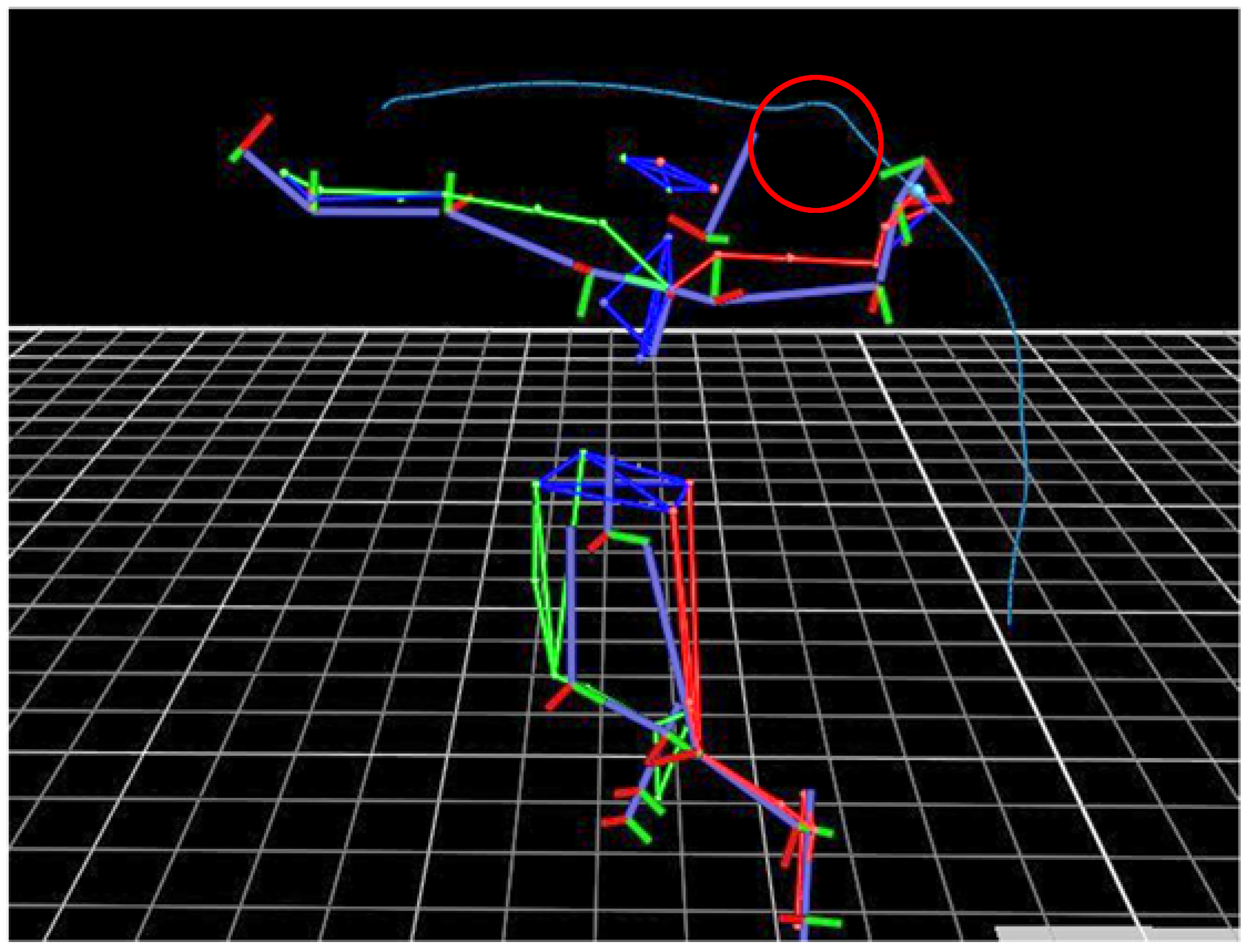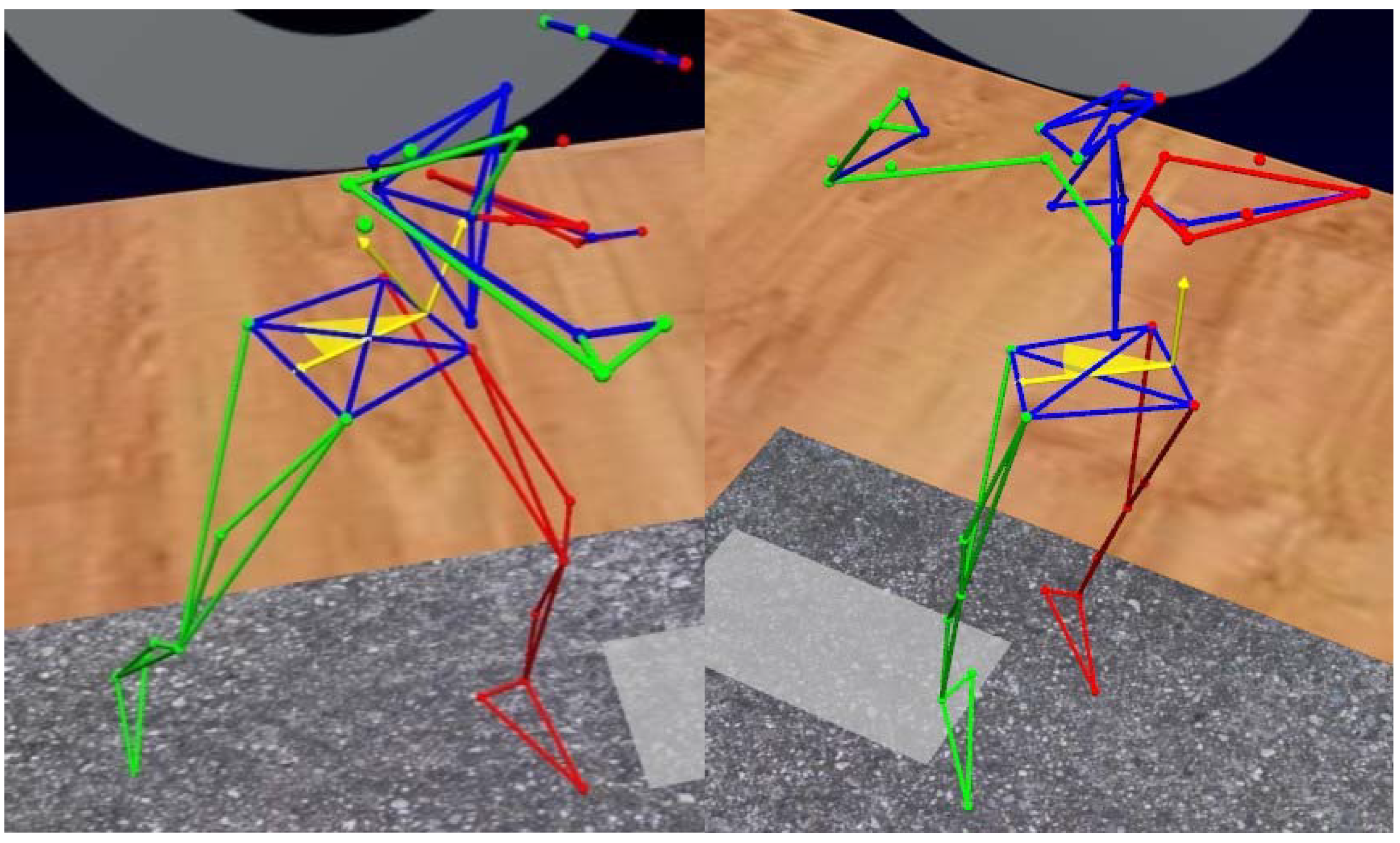A Biomechanical Evaluation of the Upper Limb Kinematic Parameters of the Throwing Action in Handball: A Case Study
Abstract
:1. Introduction
2. Materials and Methods
2.1. Study Design
2.2. Evaluation
- A warm-up of 10 min;
- An evaluation of the S1 throwing position;
- An evaluation of the S2 throwing position.
3. Results
3.1. Statistical Analysis
3.2. MANOVA Test
4. Discussion
5. Conclusions
Author Contributions
Funding
Institutional Review Board Statement
Informed Consent Statement
Data Availability Statement
Acknowledgments
Conflicts of Interest
References
- Rivilla-García, J.; Grande, I.; Chirosa, L.J.; Gómez, M.J.; Sampedro, J. Differences and relationship between standards and specific throwing test in handball according to the competitive and professional level. J. Sport Health Sci. 2011, 3, 143–152. [Google Scholar]
- Rivilla-Garcia, J.; Grande, I.; Sampedro, J.; van Den Tillaar, R. Influence of opposition on ball velocity in the handball jump throw. J. Sports Sci. Med. 2011, 10, 534–539. [Google Scholar] [PubMed]
- Garcia, J.A.; Sabido, R.; Barbado, D.; Moreno, F.J. Analysis of the relation between throwing speed and throwing accuracy in team-handball according to instruction. Eur. J. Sport Sci. 2013, 13, 149–154. [Google Scholar] [CrossRef]
- Wagner, H.; Pfusterschmied, J.; Duvillard, S.P.; Müller, E. Performance and kinematics of various throwing techniques in team-handball. J. Sports Sci. Med. 2011, 10, 73–80. [Google Scholar] [PubMed]
- Wagner, H.; Michael Buchecker, S.P.; Müller, E. Kinematic Comparison of Team Handball Throwing With Two Different Arm Positions. Int. J. Sports Physiol. Perform. 2010, 5, 469–483. [Google Scholar] [CrossRef] [PubMed]
- Wagner, H.; Müller, E. The effects of differential and variable training on the quality paramters of a handball throw. Sports Biomech. 2008, 7, 54–71. [Google Scholar] [CrossRef] [PubMed]
- Wagner, H.; Kainrath, S.; Müller, E. Koordinative und taktische Anforderungen beim Torwurf im Handball. Der Zusammenhang von Leistungsniveau, Qualität der Wurfbewergung und ausgewählten technisch-taktischen Parametem. Leistungssport 2008, 5, 35–42. [Google Scholar]
- Wagner, H.; Buchecker, M.; Duvillard, S.P.; Müller, E. Kinematic description of elite vs. low level players in team-handball jump throw. J. Sports Sci. Med. 2010, 9, 15–23. [Google Scholar] [PubMed]
- Wagner, H.; Pfusterschmied, J.; Klous, M.; Duvillard, S.P.; Müller, E. Movement variability and skill level of various throwing techniques. Hum. Mov. Sci. 2012, 31, 78–90. [Google Scholar] [CrossRef] [PubMed]
- Fradet, L. Analyse Biomécanique, Modélisation ET Simulation du Tir AU Handball. Thèse Pour Les Sciences de la Vie- Sciences ET Techniques Des Activités Physiques ET Sportives. Ph.D. Thesis, Université de Rennes II—UFR-STAPS, Rennes, France, 2003. [Google Scholar]
- Piscitelli, F.; Milanese, C.; Sandri, M.; Cavedon, V.; Zancanaro, C. Investigating predictors of ball-throwing velocity in team handball: The role of sex, anthropometry, and body composition. Sport Sci. Health 2016, 12, 11–20. [Google Scholar] [CrossRef]
- Vandelle, V. Analyse Biomécanique et Cinématique du tir au Handball pour L’amélioration de la Performance. Mémoire Et Entraînement 2013/2014. Available online: http://frederic.duclos.free.fr/Digitalisation/Prestations_APS_files/Memoire_Vincent_Vandelle.pdf (accessed on 5 January 2024).
- van den Tillaar, R.V.; Ettema, G. A comparison of overarm throwing with the dominant and nondominant arm in experienced team handball players. Percept. Mot. Ski. 2009, 109, 315–326. [Google Scholar] [CrossRef] [PubMed]
- van den Tillaar, R.V.; Cabri, J.M. Gender differences in the kinematics and ball velocity of overarm throwing in elite team handball players. J. Sports Sci. 2012, 30, 807–813. [Google Scholar] [CrossRef] [PubMed]
- Skejo, S.D.; Moller, M.; Bencke, J.; Sorensen, H. Shoulder kinematics and kinetics of team handball throwing: A scoping review. Hum. Mov. Sci. 2019, 64, 203–212. [Google Scholar] [CrossRef] [PubMed]
- Addinsoft. XLSTAT Statistical and Data Analysis Solution. New York, USA. 2023. Available online: https://www.xlstat.com/en (accessed on 1 September 2021).
- Zhang, J.; Sorby, H.; Clement, J.; Thomas, C.D.L.; Hunter, P.; Nielsen, P.; Lloyd, D.; Taylor, M. The MAP client: User-friendly musculoskeletal modelling workflows. In Proceedings of the International Symposium on Biomedical Simulation, Strasbourg, France, 16–17 October 2014; Springer: Strasbourg, France, 2014; pp. 182–192. [Google Scholar]
- Merriaux, P.; Dupuis, Y.; Boutteau, R.; Vasseur, P.; Savatier, X. A Study of Vicon System Positioning Performance. Sensors 2017, 17, 1591. [Google Scholar] [CrossRef] [PubMed]
- Van den Tillaar, R.; Ettema, G. A force-velocity relationship and coordination patterns in overarm throwing. J. Sports Sci. Med. 2004, 3, 211–219. [Google Scholar] [PubMed]







| Wrist Velocity (mm/s) S1F1 | Wrist Velocity (mm/s) S2F1 | Wrist Velocity (mm/s) S1F2 | Wrist Velocity (mm/s) S2F2 | ||
|---|---|---|---|---|---|
| Athlete P1 | Minimum | −587.747 | −1541.870 | −415.338 | 3939.870 |
| Maximum | 843.948 | 4121.530 | 9483.160 | 10,369.340 | |
| Average | 16.023 | 488.679 | 3767.244 | 6061.448 | |
| Standard deviation | 411.770 | 1467.853 | 3010.767 | 1424.689 | |
| Coefficient of variation | 25.699 | 3.004 | 0.799 | 0.235 | |
| Angular Velocity of Trunk Torsion (mm/s) S1F1 | Angular Velocity of Trunk Torsion (mm/s) S2F1 | Angular Velocity of Trunk Torsion (mm/s) S1F2 | Angular Velocity of Trunk Torsion (mm/s) S2F2 | ||
|---|---|---|---|---|---|
| Athlete P1 | Minimum | −181.042 | −333.624 | −269.893 | −536.494 |
| Maximum | −29.123 | 210.818 | −185.713 | −349.745 | |
| Average | −103.745 | 22.944 | −241.738 | −475.362 | |
| Standard deviation | 47.220 | 185.015 | 25.912 | 62.515 | |
| Coefficient of variation | −0.455 | 8.064 | −0.107 | −0.132 | |
| Angular Velocity of Arm Rotation (mm/s) S1F1 | Angular Velocity of Arm Rotation (mm/s) S2F1 | Angular Velocity of Arm Rotation (mm/s) S1F2 | Angular Velocity of Arm Rotation (mm/s) S2F2 | ||
|---|---|---|---|---|---|
| Athlete P1 | Minimum | 49.153 | −22.252 | 9.255 | 24.821 |
| Maximum | 109.128 | 306.914 | 269.482 | 251.030 | |
| Average | 87.653 | 146.314 | 97.261 | 164.478 | |
| Standard deviation | 18.382 | 118.512 | 92.065 | 77.328 | |
| Coefficient of variation | 0.210 | 0.810 | 0.947 | 0.470 | |
| Parameter and Phases | t-Test Values | ||||
|---|---|---|---|---|---|
| Kinematic Parameter Analyzed | Phase and Difference | Average | 95% Confidence Interval | p * | Null Hypothesis (Equal Average) |
| Wrist velocity | S2F1–S1F1 | −472.65 | (−887.36; −57.9) | 0.026 | reject |
| Wrist velocity | S2F2–S1F2 | −2294.2 | (−3245.37; −1343) | 0.0001 | reject |
| Angular velocity of trunk torsion | S2F1–S1F1 | −126.68 | (−194.45; −58.9) | 0.0001 | reject |
| Angular velocity of trunk torsion | S2F2–S1F2 | 233.62 | (209.96; 257.28) | 0.0001 | reject |
| Angular velocity of arm rotation | S2F1–S1F1 | −58.66 | (−101.49; −15.87) | 0.008 | reject |
| Angular velocity of arm rotation | S2F2–S1F2 | −67.21 | (−115.08; −19.34) | 0.007 | reject |
| (a) | |||
| Variables | Angular Velocity of Arm Rotation for S1F1 | Wrist Velocity for S1F1 | Angular Velocity of Trunk Torsion for S1F1 |
| Angular velocity of arm rotation for S1F1 | 1 | 0.518 | 0.981 |
| Wrist velocity for S1F1 | 0.518 | 1 | 0.408 |
| Angular velocity of trunk torsion for S1F1 | 0.981 | 0.408 | 1 |
| (b) | |||
| Variables | Angular Velocity of Arm Rotation for S1F2 | Wrist Velocity for S1F2 | Angular Velocity of Trunk Torsion for S1F2 |
| Angular velocity of arm rotation for S1F2 | 1 | −0.524 | −0.773 |
| Wrist velocity for S1F2 | −0.524 | 1 | 0.924 |
| Angular velocity of trunk torsion for S1F2 | −0.773 | 0.924 | 1 |
| (c) | |||
| Variables | Angular Velocity of Arm Rotation for S2F1 | Wrist Velocity for S2F1 | Angular Velocity of Trunk Torsion for S2F1 |
| Angular velocity of arm rotation for S2F1 | 1 | 0.863 | −0.799 |
| Wrist velocity for S2F1 | 0.863 | 1 | −0.920 |
| Angular velocity trunk torsion for S2F1 | −0.799 | −0.920 | 1 |
| (d) | |||
| Variables | Angular Velocity of Arm Rotation forS2F2 | Wrist Velocity for S2F2 | Angular Velocity of Trunk Torsion for S2F2 |
| Angular velocity of arm rotation for S2F2 | 1 | −0.989 | −0.788 |
| Wrist velocity for S2F2 | −0.989 | 1 | 0.860 |
| Angular velocity of trunk torsion for S2F2 | −0.788 | 0.860 | 1 |
| Type of Phase/Throw | Angular Velocity of Trunk Torsion for (mm/s) | Angular Velocity of Arm Rotation for (mm/s) | Wrist Velocity (mm/s) | Wilks’ Lambda | p * |
|---|---|---|---|---|---|
| F1S1 | −101.168 | 88.936 | 32.727 | 0.506 | 0.0001 |
| F1S2 | 22.944 | 146.314 | 488.679 | ||
| F2S1 | −240.097 | 95.961 | 3652.316 | 0.085 | 0.0001 |
| F2S2 | −475.362 | 164.478 | 6061.448 |
Disclaimer/Publisher’s Note: The statements, opinions and data contained in all publications are solely those of the individual author(s) and contributor(s) and not of MDPI and/or the editor(s). MDPI and/or the editor(s) disclaim responsibility for any injury to people or property resulting from any ideas, methods, instructions or products referred to in the content. |
© 2024 by the authors. Licensee MDPI, Basel, Switzerland. This article is an open access article distributed under the terms and conditions of the Creative Commons Attribution (CC BY) license (https://creativecommons.org/licenses/by/4.0/).
Share and Cite
Marin, M.I.; Robert, S.; Sakizlian, R.E.; Rusu, L.; Rusu, R.M. A Biomechanical Evaluation of the Upper Limb Kinematic Parameters of the Throwing Action in Handball: A Case Study. Appl. Sci. 2024, 14, 667. https://doi.org/10.3390/app14020667
Marin MI, Robert S, Sakizlian RE, Rusu L, Rusu RM. A Biomechanical Evaluation of the Upper Limb Kinematic Parameters of the Throwing Action in Handball: A Case Study. Applied Sciences. 2024; 14(2):667. https://doi.org/10.3390/app14020667
Chicago/Turabian StyleMarin, Mihnea Ion, Salome Robert, Robert Eduard Sakizlian, Ligia Rusu, and Robert Mihai Rusu. 2024. "A Biomechanical Evaluation of the Upper Limb Kinematic Parameters of the Throwing Action in Handball: A Case Study" Applied Sciences 14, no. 2: 667. https://doi.org/10.3390/app14020667








